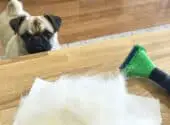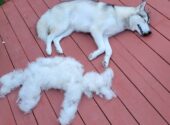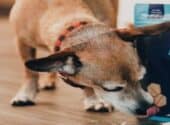Owning a dog is one of the most rewarding experiences. Not only are they fantastic pets to have, but they are also companions that become part of the family too. While they are fantastic pets to have, they are not completely without their flaws.
Just like any other animal, dogs can be mischievous and even naughty. What is important to understand is that there is always a reason why a dog is acting in a specific way, and there are ways to correct adverse behavior in the right way.
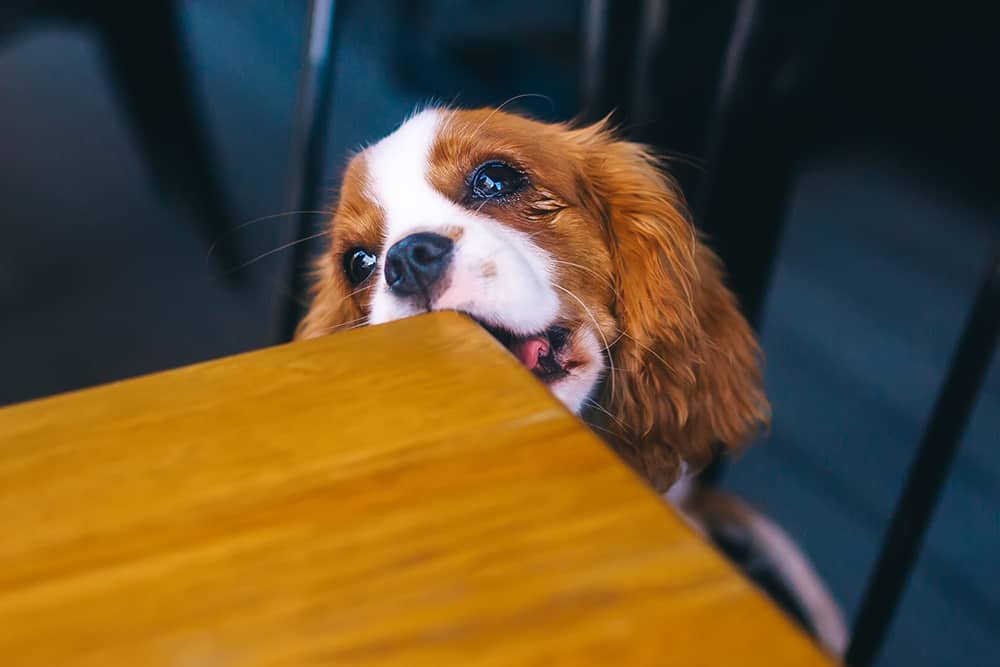
One trait in particular that many pet owners struggle with is chewing and destructive behavior.
It is even a common reason why dogs are taken to rescue shelters by their owners. While it can be frustrating if your dog has chewed your new settee, or your wood trim, it is important to understand why this is happening.
Once you have a better understanding of why your dog is chewing on wood trim, or anything it shouldn’t, it allows you to know the steps you can take to help prevent this from happening again in the future.
In this article, we will be talking you through the steps you can take to stop your dog from chewing on wood trim. We will also be delving into the possible causes for this, and how you can help your dog to stop this behavior in a few simple steps.
Reasons Why A Dog Chews On Wood Trim
Before discussing how to stop a dog from chewing on wood trim, it is important to get to the root of the problem. You want to ask yourself the question of why your dog has decided to chew on the wood trim.
While you may think that it is just your dog displaying “naughty” tendencies, this is not usually the case. Typically, it is a sign that not all is well with the dog. There are many reasons why this may be the case. We will be discussing the most common causes for this behavior.
Teething
A common reason why a dog will chew on wood trim when it is a puppy is due to teething. When a dog is teething, this can be irritating and painful for them. As a result, their natural instinct is to chew on different objects.
The objects a puppy will decide to chew on does depend on that particular dog. However, wood, and household furniture is typically a popular choice given that it is quite solid.
This is something you will want to prevent, as a puppy can easily injure its mouth and digestive system through chewing and potentially ingesting the wood.
Separation Anxiety
Separation anxiety is a common cause for chewing on wood trim in dogs. While it is common behavior for puppies and rescue dogs, any age of dog can suffer from separation anxiety.
This anxiety when their owners and loved ones leave them alone in the house is caused by high levels of stress and the dog being unsure. Often when a dog is anxious, they will display destructive tendencies as a way of them helping to calm themselves down.
While this is something humans struggle to relate to, for a dog, it can be helpful at the time.
However, separation anxiety is a problem. Not only is it frustrating and upsetting for the owner to come home to, but the stress it causes a dog is not healthy, and needs to be addressed.
Boredom
Dogs need a certain level of mental stimulation. This is why it is pivotal for dogs to have enough toys and distractions when they are home alone.
If they do not have enough to keep themselves occupied, this can cause them to find their own ways of being amused.
More often than not, this leads to destructive behavior. The dog is using up the energy and boredom it has by chewing on things it shouldn’t to help relieve the under stimulation it is feeling.
Lack Of Training
When owning a dog, training is such an important part to consider. If a dog is not correctly trained, it will not have a clear understanding of its boundaries. Boundaries are important because they help a dog to understand what is acceptable and what is not acceptable.
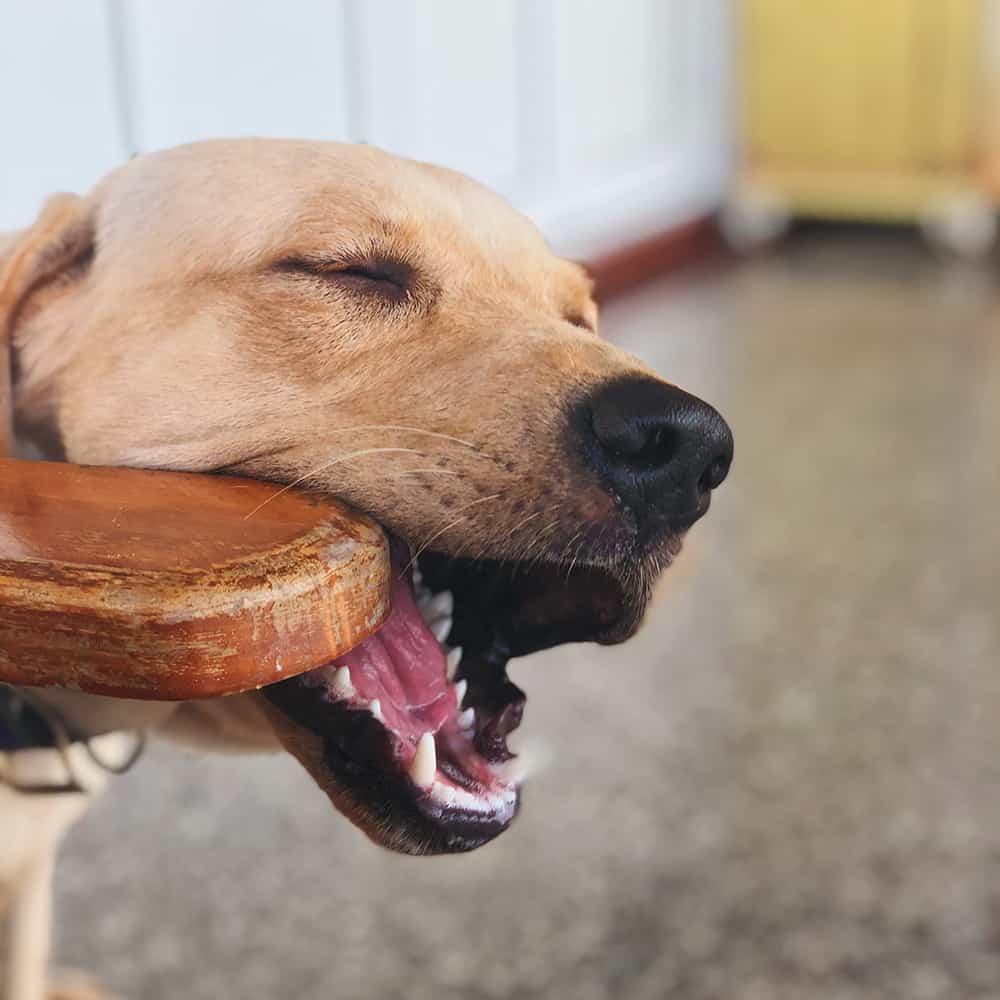
If a dog has not been trained to not chew on the wood trim, you cannot expect the dog to not do this. Just how a dog will not learn other commands without being trained to do so.
Lack Of Exercise
Finally, the last most common reason why a dog will chew on wood trim is due to a lack of exercise. This ties in closely with the lack of stimulation because walks allow a dog to use up the pent-up energy it has.
If a dog has not been exercised, especially if it is a high-energy dog, or a puppy, this energy can quickly turn destructive when you are not in the house to supervise your dog’s activities.
How To Stop A Dog From Chewing On Wood Trim?
It is worth noting that chewing on different things is a natural behavior for dogs, and it is not something that you will want to stop your dog from doing completely, especially when they are a puppy.
Chewing is helpful for a dog, and it is a way of relieving teething pain for puppies. As a result of this, you will want to encourage your dog to redirect its chewing instead. In this section, we will be discussing how to stop a dog from chewing on wood trim.
While the preventative measures are not instantaneous and do take time to implement, it is certainly worth it in the long run.
Correct Training
In order to stop your dog from chewing on wood trim, you need to use the correct training techniques.
These techniques will vary slightly depending on your dog and their specific training needs. This is why it is important to reach out to a professional dog trainer if you are looking for help and support regarding this.
When it comes to the training process, you will want to keep a close eye on your dog and its reactions. If you see your dog is chewing on the wood, you will want to firmly say no, and divert its attention.
Providing your dog with a chew toy and moving them away from the area is useful. This allows them to understand that the action of chewing is okay, but teaches them that it is the toy they should be chewing, rather than the wood trim.
There are specific teething and chew toys that can be purchased for a dog which are useful, such as: Dog Toys for Large Dogs and Nylabone.
Being calm and patient is important, as your dog will not learn this behavior overnight. You don’t want to yell at the dog or be forceful in any way. Positive reinforcement is needed, and rewarding good behavior is key.
If your dog has separation anxiety, this can take a number of months, and even years to overcome. A lot of patience is needed, and you will want to take things slowly.
Start by practicing picking up your keys, or putting your coat and shoes on in front of the dog. Take them back off and then sit down to get your dog used to you getting ready to leave the house.
From here, you can slowly build up the amount of time your dog is left for. Try walking to the top of the block and back to see how the dog reacts. Over time, when your dog realizes you are coming back, they will begin to settle and become more comfortable and confident with being left alone.
Chew Deterrent
Through the training process, it is useful to use a chew deterrent spray made specifically for dogs. This doesn’t harm the dog in any way. Instead, it has a bitter and unpleasant taste that the majority of dog’s aren’t keen on.
While some dogs will ignore the taste, the vast majority will be deterred from chewing the wood again due to the taste. Given that it is inexpensive to purchase, it is worth trying out, as it can help with the training process.
Here is a great chew deterrent to consider: Grannicks Bitter Apple Taste Deterrent for Dogs.
Barriers
Where possible, when you are not in the home and cannot train your dog or tell them no, you should try to use physical barriers. This helps to prevent the dog from reaching the area they have been chewing.

While this is useful, care will need to be taken to ensure that the dog is not going to injure itself trying to reach the wood. Some dogs if they are reacting due to separation anxiety can become destructive to barriers too.
This is something you will want to practice and assess before leaving your dog unattended to ensure that it is going to work.
Plenty Of Mental Stimulation
A dog needs plenty of mental stimulation, especially if you own a high energy, and intelligent breed.
Having enough toys that your dog is interested in when you leave is important. Every dog has different preferences when it comes to toys, and you will know the toys your dog loves the most.
In addition to this, choosing suitable chews and treats can be useful too. This will help to keep your dog preoccupied and busy when you leave the house.
Dog toys that treats can be hidden in are a great idea because it will keep the dog interested and mentally stimulated as you leave.
Here are some great options to consider:
- KONG – Classic Dog Toy paired with KONG – Easy Treat – Dog Treat Paste
- Nina Ottosson By Outward Hound – Interactive Puzzle Game Dog Toys
- AWOOF Pet Snuffle Mat for Dogs
Exercise
Finally, a great way in which you can help to prevent destructive behavior and your dog chewing on wood trim is through exercise. It is no surprise that exercise is a very important part of owning a dog.
Without the exercise needed, a dog can quickly become destructive. This is because of all of the energy they are not able to dispel. This is particularly true for energetic dogs and puppies.
As a result, you will want to ensure that your dog is being walked daily, in accordance to how much exercise the specific breed needs. If the dog has been exercised enough, especially if this was just before you leave, they will be less likely to carry out destructive behavior.
Exercise combined with enough mental stimulation will tackle both aspects of excess energy that a dog has, which can be particularly useful.
Summary
We hope you have found this article useful and insightful. As you can see, teaching your dog to stop chewing on wood trim is not rocket science. While it does take patience and perseverance, it is more than possible to do so.
Getting to the root of the chewing is essential. This will help you to have a better understanding of your dog and why they are acting in a certain way.
From here, you can then decide on the best training methods to deal with the issue head on. This will then help you to train your dog to stop chewing on wood trim.
In addition to this, using a chew deterrent is useful as it will help to discourage the chewing during the training process, and while you are not at home to supervise the dog. When it comes to using these techniques, don’t be afraid to use a few of these methods simultaneously.

